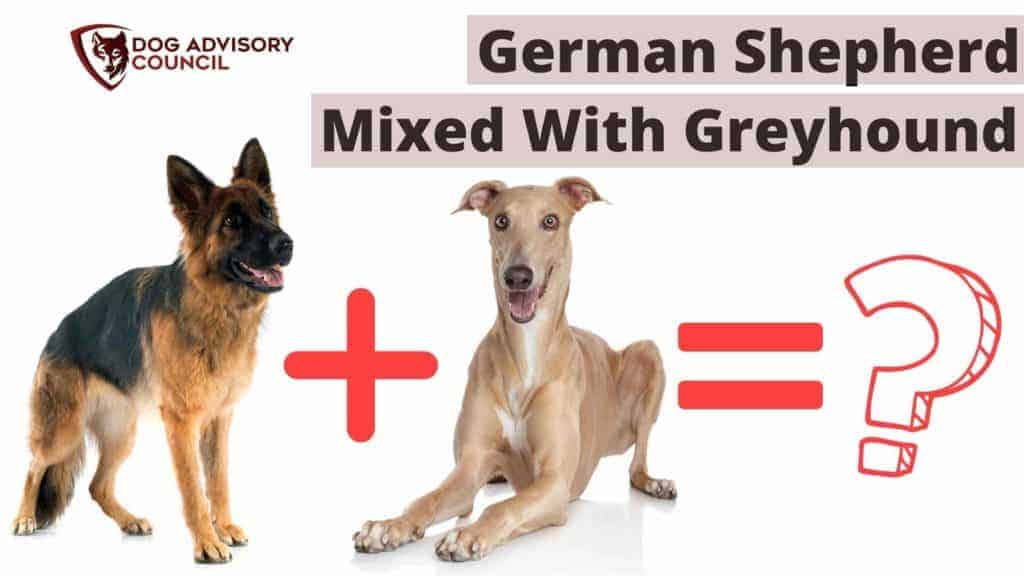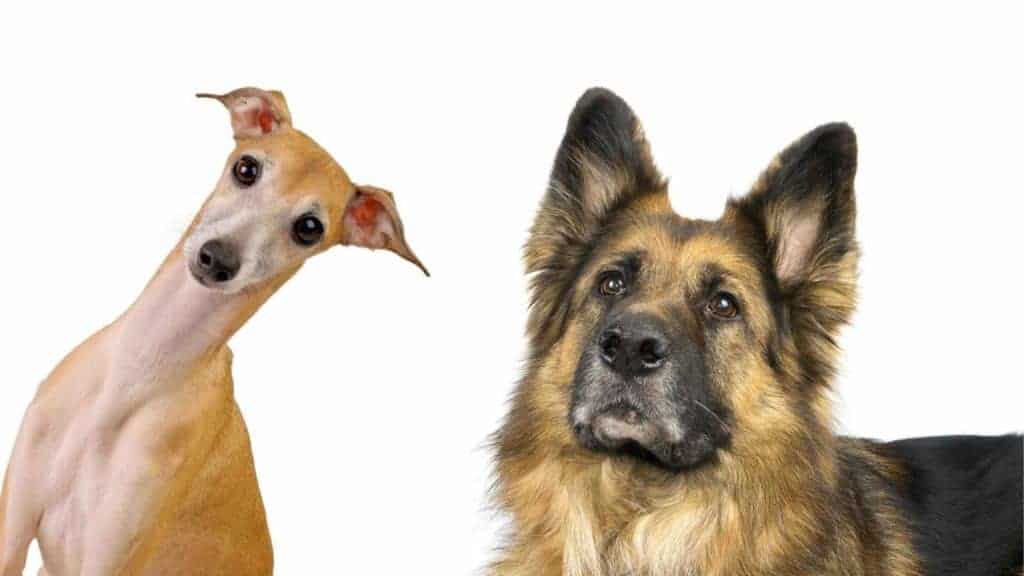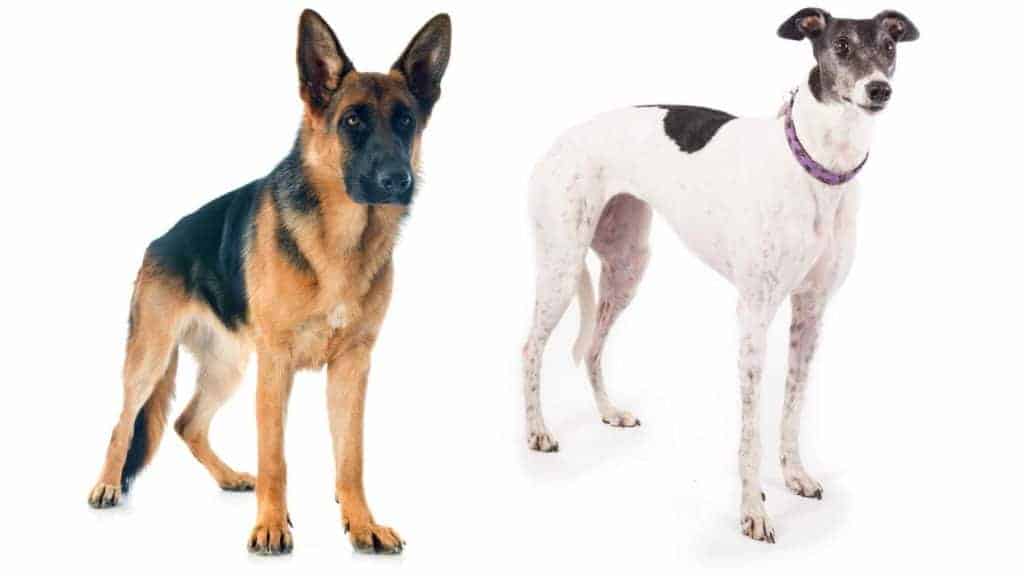
German Shepherd mixed with Greyhound sounds like a really intriguing dog mix, and we have to agree. It is loaded with all sorts of great features. Curious to know how these breeds come together to form a mixed breed? Keep reading!
This is a relatively new mixed-breed dog featuring one parent that’s a German Shepherd and one that is a Greyhound.
This is a medium-to-large dog that will measure to be 25-30 inches (63-70 cm) high and weigh between 50-110 pounds (22-49 kg).
They are friendly, cuddly, fast, and active dogs. They can be prone to anxiety and other large dogs’ health concerns.
Proper knowledge of parent breeds and training is essential when becoming a pet parent to this dog breed.
What is a German Shepherd mixed with a Greyhound called?
This mixed breed has quite a few names that you can use, depending on your preferences. One of the most common ones is a German Greyhound. You’ll also hear Greyhound Shep and even the adorable use of Shep-a-Grey!
The one that you choose depends on what you prefer most, of course. You’ll also find some people are familiar with one name more than the other.
What does a German Shepherd Greyhound mix look like?
This is where the best answer that we can give is pretty much just to spin the wheel and have fun putting features together!
These dog breeds look nothing alike on their own, and the puppies will be a fun mix of all of these features put together in varying patterns and markings.
As far as general details are concerned, the primary coat colors for this mix include:
- Black
- Brown
- Brindle
- Fawn
- Blue
- Red
Some may have German Shepherd markings or not. Their overall size tends to take the fun silhouette of a Greyhound with a slightly wider face and shoulders. They are muscular and known for being “all muscle.”
They typically have short fur, which will be a bit longer than a Greyhound’s typical fur type. It can be delicate and silky or coarse like a German Shepherd.
Sometimes they will have slightly shaggy fur, which is common when they have Shepherd markings and coat colors. Sometimes they can be brindled with shaggy fur. Often it is going to be “light shaggy” rather than thick and dense fur. It really does create a special dog breed just in looks alone!
How big can a German Shepherd Greyhound mix get?
Some are considered medium, and others are thoroughly large dogs. For this reason, people will meet in the middle and consider them to be medium-to-large dogs.
As mentioned above, they will be between 25-30 inches (63-70 cm) high and weigh between 50-110 pounds (22-49 kg).
The size will vary depending on both parents and their measurements. It also will depend on which parent’s genetics are stronger in the puppy itself. This is especially so when looking at the sheer difference in the weight of the dog!
The best way to get a feel for this is to ask for the measurements of both parent dogs. This will give you an inside and outside height and weight that you can expect.
The German Shepherd greyhound mix lifespan
One of the most important things when working with a dog and adding one to your family is the lifespan. This takes on the best of both breeds and often will be between 10-13 years. Most of these years will be healthy and happy, with only a few health issues to note (more on that in a bit).
What is the temperament of a German Shepherd Greyhound mix?
Without question, a German Greyhound is going to be fun. They are an exceptional blend of both parent breeds, making them pleasant, alert, active, friendly, fun, and playful. They are good family dogs and will get along well with their human and furry companions.
They are happiest when spending time with their family and will always want to be nearby so that they can see what you’re doing and hopefully join in.
It’s important to note that these are very active dogs. While they are cuddly and affectionate, they also require a lot of exercise. They will need to get that exercise to stay healthy.
Hyperactive at times, they can sometimes knock things over if they get excited when playing, including children or other pets. So this is something to consider if you’ve got young ones.
One interesting detail is that these dogs can be known for matching their energy with yours. That is, when you are tired and will want to cuddle, they’ll join in happily. When you want to go out for a run and burn off some energy, they will do. While they aren’t mind-readers, this adaptable feature is a great thing to look into!
While prone to excitement, these aren’t aggressive dogs. Even though they have the German Shepherd in them, the gentle nature of the Greyhound tends to wash both out to be a comfortable neutral. There isn’t much information on whether or not a German Greyhound will be a good guard dog or not.
Unlike some of the other breeds out there, they thrive on having other animals near them. They love being in families with multiple dogs, cats, and more. They will often be lonely if they are in a household with no other pets, so this is something to think about.

Are German Shepherd Greyhound mixes good family dogs?
Absolutely! They are easy additions to a modern household of kids and pets, as introduced briefly above. One of the best features of this mix is that they so love being around other pets and humans both.
German Greyhounds will always want to be in the center of everything, and they will travel along with you from the living room to the backyard, to a camping trip, and so on.
While they are gentle dogs, to be sure, you will want to be careful of these if you have little ones that are especially small.
Since they can weigh between 50-110 pounds (22-49 kg), it means that they could get a little too enthusiastic while playing and accidentally knock a child over. The same goes for delicate items on coffee tables.
They aren’t aggressive or intentionally destructive. They are just big and muscular dogs, so they are thought to be very strong.
These are not dogs for apartments or small homes. They must have room to move and play without worrying about bumping into something or someone every time they try to turn around.
Shephound health issues
This mixed breed can have a few general health issues to know about. Some of these are breed-specific, but most are related to size:
- Hip or elbow dysplasia
- Bloat
- Allergies
- Skin issues
- Anxiety
Hip or elbow dysplasia
This is one of the most common health concerns for large dogs. Because their bones and joints are so large and susceptible, they can “grow into” dysplasia in either, or both, joints.
This is when the joint and the bone do not work correctly. The socket does not hold the bone properly and causes friction in the movement.
This is often common when the dogs are 3 years old and older, but it depends on the dog itself.
Bloat
This is a potentially serious issue with dogs, unfortunately. This is when the stomach twists and causes gases to build up and create swelling in the stomach itself.
This puts pressure on other organs, impacting their proper function. This could include reduced lung capacity and a decreased heart rate. It is something that needs immediate vet attention since it can be fatal if left untreated!
Allergies
German Shepherds, in particular, are prone to allergies. It is most commonly a food allergy, and it can be in the byproducts of typical dog kibble.
You’ll want to request an entire history from your breeder when you purchase your German Greyhound puppy, of course, which will help predict allergies in your puppy.
However, you can also consider having a professional allergy test done if you want to know for sure.
Skin issues
This comes from Greyhounds. Since they have short and fine fur, their skin can b especially sensitive.
Even if they have shaggy fur, you will need to factor skincare into taking proper care of your Greyhound Shep, which we will expand on in a bit.
Anxiety
This is due mainly to the Greyhound in them. These are naturally anxious dogs due to a long breed-specific history of abused racing dogs conditioned to be naturally very fearful.
Even though your puppy is coming from a cruelty-free background with the breeder, this breed itself is naturally anxious, thanks to the sheer amount of abuse in its “ancestral” history.
Anxiety doesn’t necessarily need to be controlled with medication. Still, it will mean a few lifestyle changes as far as training (we’ll talk about that in a bit) and understanding that this may always be a bit of a concern when introducing them to new people and new experiences. Many think that this is why they love other animals soo much — there is safety in numbers!
What is the cost of a German Shepherd Greyhound mix?
While not a recognized breed by the AKC, this is a popular puppy nonetheless.
However, there aren’t many breeders who do offer it. As such, you can expect to pay the price anywhere between $1 000 to $4 000.
You may even pay more if you are requesting the rarer blue or red coat colors and other kinds of breeding specifics.
How to take care of a Shephound
When you want to be the best parent you can be, you’ll want to focus some attention on the following factors for your Shep-a-Grey:
- Grooming and bathing
- Exercise and space
- Anxiety treatment
- Training
Grooming and bathing
Some of these dogs will be moderate shedders, and others will be light. All will shed at least a little bit, so this is something to think about.
You will want to brush them at least once a week, perhaps once every 2 weeks if your dog’s fur is especially short. Over-doing the brushing can make skin problems worse.
You will want to bathe your dog regularly. Most will recommend once every 6-8 weeks. This helps keep their fur and skin clean, and since groomers will use the professional techniques and products, it will help nourish and properly care for their skin and fur at the same time.
Exercise and space
The need for exercise is something to think about seriously. Both parent breeds are very high-energy naturally, resulting in a high-energy puppy.
Most will need at least 90 minutes per day. This should blend fast-paced energy (for its Greyhound genes) and play, or swimming or walking (for its German Shepherd genes.)
Having a yard where you can get them going is a great idea. It allows them to run free and move around as much as they want to, but you can still keep them in your sight. As mentioned, these are not dogs that will fit into small houses with no outdoor spaces or apartments.
Anxiety treatment
Thanks to ancestral memory, a Shep-a-Grey will need a soft hand and kind heart as far as parents. Even in the best-case scenario, your dog may suffer from moderate anxiety.
You can talk to your vet about therapies if you wish. In most cases, using soft voices and ensuring they have a designated safe space to rest and recharge is excellent.
You will want to ensure that you take on their anxiety wholeheartedly to know how to work with them as an ally rather than an enemy. This can even make it worse. Your breeder, vet, and behavior specialist can all help with this for long-term support and help if needed.
Training
You’ll be happy to know that these mixed breeds do train well. They love to listen to their owners and are intelligent.
The main focus with these, however, is to ensure that you use positive reinforcement. Negative reinforcement (yelling and chastising) doesn’t generally work with dogs at all, and these will have a very negative experience thanks to their abusive history.
When approaching all types of training, you’ll always want to have a positive angle so that you can help them learn without making them associate training with fear or you with fear. Both are going to make for a bad long-term relationship on both ends.

Pros and cons of a Shep-a-Grey
So, with all of the said, the time has come for you to take a look at the pros and cons of this mixed breed. The highlights in this decision include:
PROS
- Great for homes with multiple dogs
- Friendly and affectionate
- Will “meet you where you are” for energy
A German Greyhound is going to be a wonderful choice when you are looking specifically at the idea of having a dog that will go with you from Point A to Point B, settle into the family, and all of its various people and dogs. You will also enjoy that they have this tendency to simply be right where you are as far as energy and focus.
CONS
- Need an experienced dog owner
- Need lots of space
Since they are high-energy dogs, they will need space to run and owners who will be dedicated to helping them get the exercise they need for health purposes.
They will require an experienced dog owner for training. This is because positive reinforcement tends to be a learned trait for dog parents. Thanks to their muscle mass, you’ll also need to physically be strong since they can be hard to control when they need it.
Think carefully
This is not a dog for beginners, though many make this mistake. This means that quite a high population of them end up back at the breeders or abandoned at animal shelters not equipped to deal with them.
For everyone’s health and safety, please think carefully and seriously about your decision so that you can make the right one both for you and your potential dog. This is the best way to protect everyone long-term!
In brief
A German Shepherd Greyhound mix is a medium-to-large dog that will measure to be 25-30 inches (63-70 cm) high and weigh between 50-110 pounds (22-49 kg) at full size.
They are loving, great with kids and animals, and very active. Prone to anxiety, these unique dogs are recommended for experienced dog owners for the best result.
A German Shepherd Greyhound mix might not be a popular dog breed compared to other types, but they’re certainly great options when looking specifically for a family-friendly dog that loves to be in the middle of everything.
Know someone hunting for all of these things? Consider introducing them to this sweet dog!
